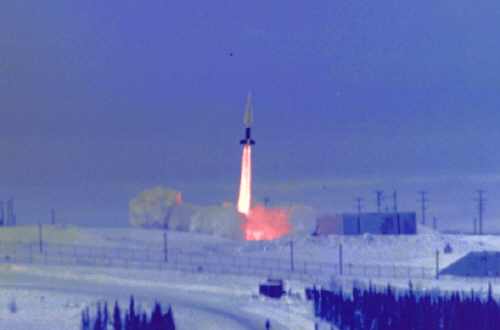Site LOVE
ALASKA

Echo Battery
2nd Missile Battalion, 562nd Artillery



Updated 29 December, 2011




Updated 29 December, 2011
E Battery, 2nd Battalion, 562nd Artillery was one of five Nike-Hercules missile firing batteries that were deployed to provide a defensive ring of supersonic fire around the Fairbanks/Eielson AFB complex during the height of the Cold War. This webpage is an attempt to preserve some memory of the place and time that is rapidly disappearing. If you stumbled across this webpage by means other than the link from the NIKE-HERCULES ALASKA INDEX page, you may wish to go there first for a little background information before proceeding. Please CLICK HERE to do so, then follow the link back to Site LOVE. Thank you.
In the mid 1950's, in response to a growing Soviet bomber threat, northern Alaska was programmed to receive two Nike Hercules battalions consisting of eight firing batteries. One battalion, comprised of four firing batteries, would defend Eielson Air Force base and the other, also with four firing batteries would defend Ladd Air Force base in Fairbanks. The four Eielson batteries (Sites Jig, Tare, Mike, and Peter) were constructed and subsequently activated on 16 October, 1957.
Earlier that year the batteries planned for Ladd AFB were cancelled but recognizing that the Fort Wainwright/Eielson AFB defense had been planned as an integrated defense, the decision was made to proceed with building one of the Ladd AFB batteries. Consequently, Site Love was approved and constructed, and became operational on 15 December, 1960.
Like the other Alaskan Nike sites, LOVE's radars had improved electronic countermeasure capabilities and could sort through heavy radar jamming transmitted by Soviet bombers. The missiles were housed in above ground steel reinforced concrete bunkers (magazines). The use of deadly force was authorized to protect the missiles and warheads which were guarded by military police and large guard dogs.
Site LOVE was home to more than 100 officers and enlisted personnel who served for 18 months and then rotated to another Army assignment, many to Viet Nam service. Civilian contractors lived on site and performed non-military functions, such as plumbing, communications, road and other maintenance functions.
Many Site LOVE troops will remember Barney, the civilian contractor and authentic Alaskan sourdough, who kept the roads cleared of snow and operated the heavy equipment. Barney spent many hours spinning his yarns about living and working in Alaska and his days as a gold miner in Fox.
Located roughly 10 miles northwest of Fairbanks, Alaska, Site LOVE was the northernmost of all of the Alaskan Nike Hercules missile batteries. It was the only site situated north of the Chena River and was far removed from the four batteries surrounding Eielson AFB. The site was accessed from Murphy Dome Road, the road which eventually led to the Murphy Dome NORAD Control Center and AADCP for the Fairbanks defense.
To reach the access road, one headed northeast out of Fairbanks on the Steese Highway, turned left at Fox, which was a major gold dredging area, and headed north on the Elliot Highway to Murphy Dome Road.
A US Army lieutenant assigned to the AADCP at Murphy Dome, remembers that the Soviets frequently probed the Alaskan air defenses by flying up and down off the Alaskan coast to see what the air defense response would be. The "hot status" battery would be called up to the highest state of alert and fighter interceptors would scramble to intercept the intruders. When the Soviets would head home the fighters would return, often tracked by the hot battery in case the returning fighters (that may be low on fuel) needed rescue assistance.
Conditions at Murphy Dome were especially harsh, even for Alaska. The Murphy Dome lieutenant states: "We were totally snowed in at Murphy Dome from late November through late March. In the heart of the winter, the tunnels connecting the BOQ and other parts of Murphy Dome were coated by 3 inches of ice. We had to call in our lounge food and beverage order to Fort Wainwright, which brought it in by chopper once a month. Mail was brought in by chopper twice a week. The road to Fairbanks was closed by snow for the same period, but we survived and thrived at Murphy Dome." (officially a hardship tour , but one has to wonder).
Site LOVE and the other Fairbanks batteries participated in the "hot", "one hour" and "released for maintenance" weekly readiness status rotation in effect for the Fairbanks defense. Five batteries made this readiness rotation somewhat easier, but there were times when only one or two batteries would be available due to maintenance issues. "Hot" status required being on site 24/7 and performing hourly equipment checks, including live tracking of an incoming aircraft if one was flying. The thrice weekly Pan Am flight arriving at Fairbanks at 2 AM was a convenient live target as were the U-2 spy planes which were leaving for or returning from missions over the Soviet Union (never confirmed by the Air Force, but widely known to Site LOVE personnel).
"Hot" status also meant that an Operations Readiness Evaluation (ORE) could be conducted by headquarters with little or no notice. Site LOVE had friendly lookouts; usually civilians who lived in Fox who would warn the battery that inspectors were on the way. Upon arrival, the inspectors found the equipment primed and ready to go and the crew mysteriously close to their duty stations.
Site LOVE was especially proficient at achieving high scores on the ORE's which were a testament to the training and quality of the enlisted and officer personnel stationed there. This quality of personnel was also demonstrated at the live firings of missiles at annual service practice evaluations (SNAP) conducted at Site PETER (B battery east of Eielson Air Force base).
A Site Love Battery Control Officer remembers having the honor of firing missiles in the winter of 1967 in both surface-to-air and surface-to-surface missions at B battery SNAP. The photo of a live firing at the top of this webpage was the surface-to-air bird that found its target, landing ten feet away from the designated point 80 miles down range.
Not every minute was spent at hot status or doing the daily chores required by the US Army. The troops assigned to Site LOVE were also busy with off-site activities which included trips to Fairbanks to soak up the local culture as well as hunting, fishing and gold mining in the local area. Wildlife was plentiful, with local streams full of arctic grayling and the surrounding hills home to moose, black bears and herds of caribou.
The aforementioned Battery Control Officer (who served as the Integrated Fire Control platoon leader and Executive Officer from 1966 to 1968) tells of arriving at the battery to begin a week of activity only to find the remains of a gutted caribou on the floor of his office which had been bagged by the battery troops over the weekend.
The village of Fox, located at the intersection of the Steese and Elliot Highways, was a local gold mining area where dredges carved up acres of ground extracting gold. The dredges only retrieved the large gold nuggets, leaving gold dust and small nuggets to be retrieved by sluicing or panning. In recent years, mining claims have been placed there. An inquiry made by one of these claimants resulted in this response from one veteran of the site:
"I was at site LOVE in the 1960's. My last post before I got discharged. But while I was there I watched the mess sergeant take his pickup and 5 mess hall barrels and go down to the gold dredge at fox. At the mounds that were left behind the dredge he would fill the mess hall barrels and bring them back to behind the mess hall where he had built a sluice. Then he would put in a couple of shovels full, put the mess hall hose at the top, and turn on the water at a slow speed to flush the dirt down the sluice and go in and drink a cup of coffee. Then he'd go back out and take the gold out and repeat the process over and over. When I left the site he told me he already had about $50,000 in gold and in the 1960's that's a lot of money.
"But what I wanted to tell who ever is looking to find gold there, is that when he was done sluicing he would take the rest of the dirt (and some of it still had gold in it) and he threw it around the site because he said the sluice would never catch it all. So good luck to whoever wants to try to find gold on that rock of a hill".
In the face of budgetary constraints imposed by the protracted Vietnam war, the changing Soviet threat, and therefore changes in the defensive requirements of NORAD, units of the 2nd Missile Battallion, 562nd Artillery were being deactivated in 1970 and 1971. Site LOVE was closed in June of 1971. It is understood that the equipment, missiles and warheads were shipped to storage in the lower 48. Non-essential equipment, such as chairs, tables, desks, and other items were buried at the site in a large hole bull dozed open by Barney, the road grader operator.
The Nike sites in the Anchorage area continued operations until 1979, but since that time no Nike-Hercules missile men have walked the halls of these decaying facilites.
In the intervening years the buildings in the launcher area and the IFC area were cleared of asbestos and other hazardous materials and bulldozed into oblivion. The area was leveled and seeded, leaving no trace of the site's ten year military history.
Although nothing physical remains of Site LOVE today, Echo Battery, along with the other batteries of the 2/562 accomplished their mission. The Soviet bomber threat was blunted and Fort Wainwright and Eielson AFB were kept safe and ready to perform their missions.
The bulk of the above article was graciously provided by Romeo Whiskey Romeo, 17 November 2011.
- Juliet Tango Sierra,
29 December, 2011
